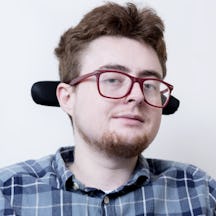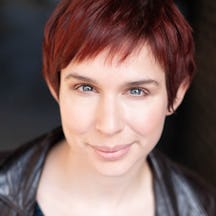Jamie Hale has to continually modify their creative expression – as a poet and performer, writer and curator – to accommodate their physical impairment. In discussion with two disabled visual artists, they explore the crucial combination of talent and technology involved in making great art.
Talent, tech and visual art
Words by Jamie Haleaudio by Kirsten Irvingaverage reading time 6 minutes
- Article
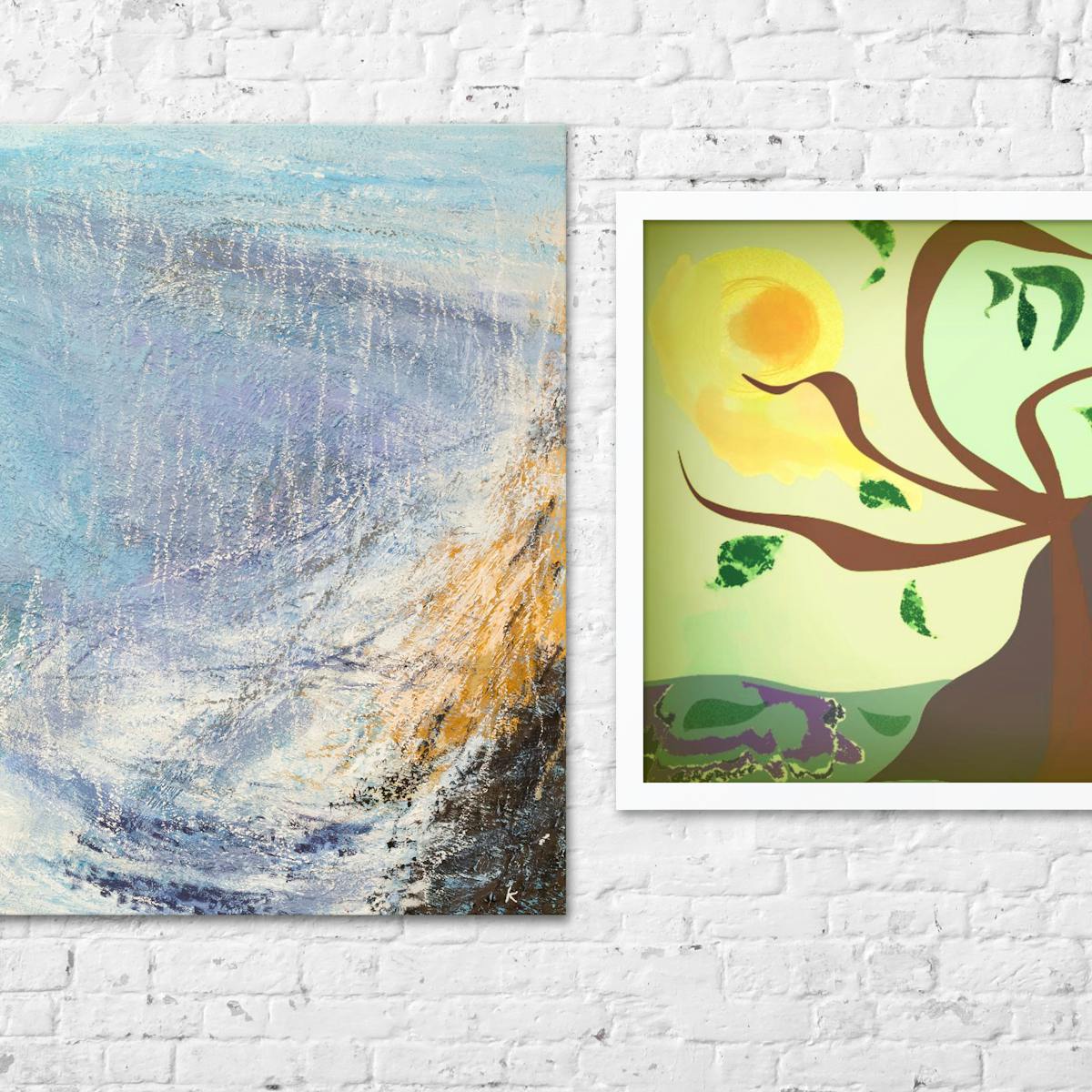
Listen
Keith Salmon, a landscape artist with a visual impairment, and Sarah Ezekiel, an artist creating work with her gaze alone, prove that our eyes can do so much more than look, and that great art can be created or interpreted with senses other than our eyes.
As my own creative practice is limited by physical impairment, I am often modifying how I work and what I produce. I want to understand the barriers Keith and Sarah face, the technologies that are shaping their art, and how they keep working as their circumstances change.
For Keith Salmon, whose work is most often inspired by the mountains where he lives in Scotland, painting isn’t about capturing what a place looks like but how it feels. His work tries to “convey something of my experience of being in these places: the cold, the shimmery light, the wind”. Hillwalking is a central part of Keith’s creative process, and it gives him an “incredible amount of information and excitement”. He won the prestigious Jolomo Award for his landscape art in 2009.
Sarah Ezekiel’s background is pastels, watercolours and acrylics, but as her motor neurone disease (MND) progressed, she began creating art using a computer. After her career, plus “travel, marriage and babies”, and then the MND diagnosis, Sarah thought her dreams of being an artist were over. Instead, it was the opposite: “MND gave me a window of opportunity and being able to create again has made me more content,” she says. She’s the foremost eyegaze artist working in the UK right now.

Left: Keith making sound recordings near Kylesku, Sutherland. Right: Sarah with a billboard advertising a film – which was banned for being ‘disturbing’ – to promote awareness of MND.
Wild places and bold art
When Keith Salmon started out, “A lot of my work was based on man-made structures, then I came to Scotland and started walking so much that I decided to combine the two interests… I get so excited by wild places.”
Ten years into losing his sight, he went on a summer mountaineering course for blind and visually impaired people with the Mountaineering Council of Scotland (now known as Mountaineering Scotland). Keith says this “transformed and opened everything up, and it opened my art up as well”. Continuing hillwalking has kept him painting.
When making dramatic changes to a painting he can only see part of, “The moment that I decide to mix the paint and get the big brush out and make that kind of move – that is really quite scary.” However, Keith is clear that this is “what creating paintings for me is about. It’s not about being safe. I think if you are too safe you don’t do your best stuff.”
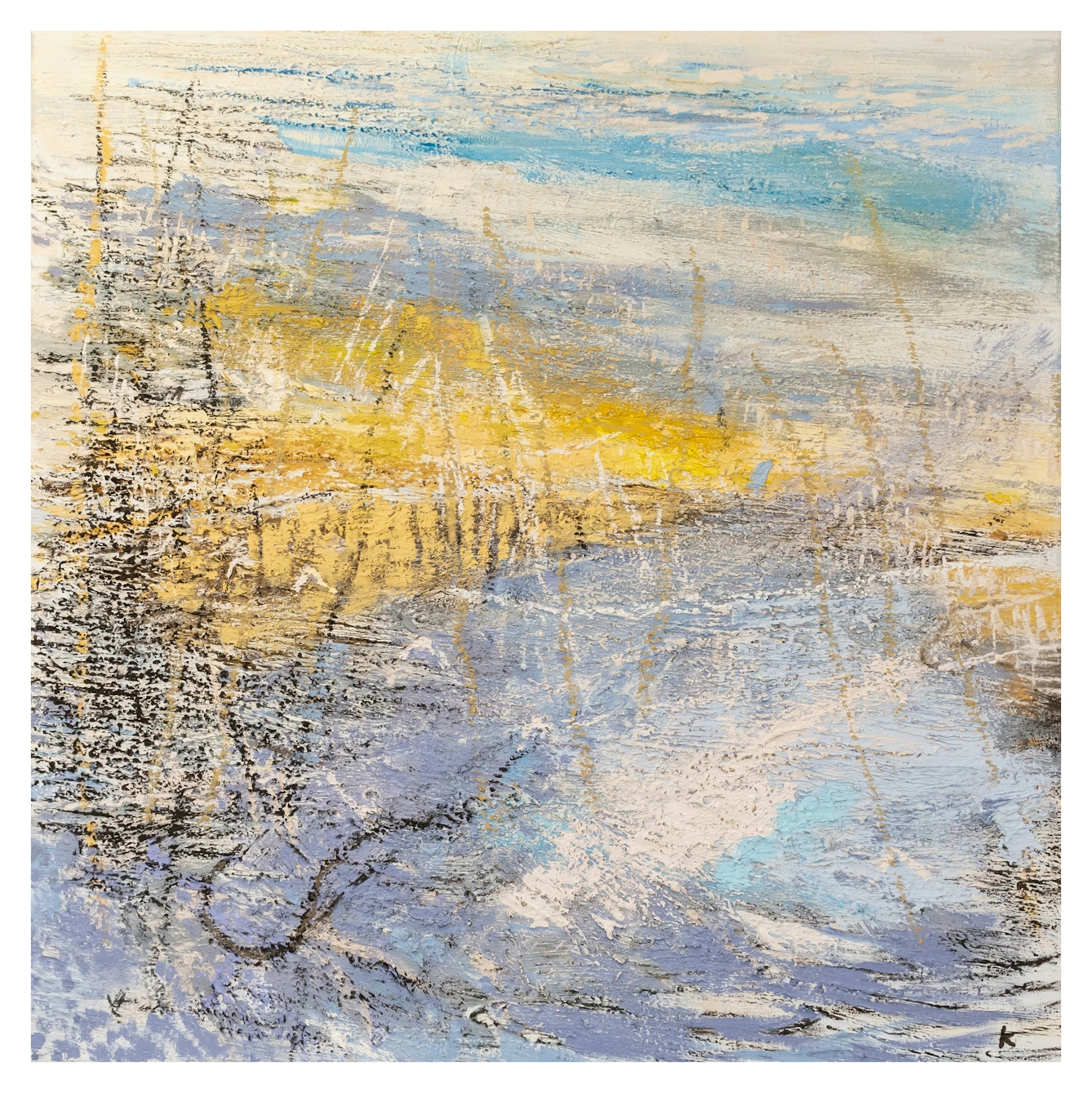
Excerpt from the Kylesku Project. Painting 2: Mid-morning. Oil on canvas. 120cm x 120cm. Audio: KBS Audio Artwork. © Keith Salmon
Listen
Paintings with soundscapes and poetry
Technology has changed the way Keith creates art. In 2016 he collaborated with Microsoft on the Oregon Project, using body sensors and soundscapes to make visual art more accessible to blind and visually impaired audiences. He was already working with sound in his own work, but this saw him using sensors to project location-sensitive sound at individual audience members so they could ‘hear’ variations in the paintings as they moved around them.
Keith continues to make recordings while out walking, and he works with sound engineers to turn these into soundtracks. He’s just finished a set of five paintings to be accompanied by a half-hour soundtrack, which, in an early iteration, “felt really good”.
As Keith’s sight loss progresses, the soundscapes enhance the visual image. He knows there are “successful totally blind painters out there”, but says, “I’m not sure it’s for me.” Instead he talks about enhancing his soundscapes as his art becomes increasingly minimalist, or “painting with words” using poetry, or writing descriptions of paintings onto canvases of the same size.
“If I did become totally blind, as well as doing the audio stuff I could do written paintings and maybe the two will combine, because maybe what I wrote would be what I heard from the soundtracks,” Keith says. This would ensure that, if he goes completely blind, “I can still be a landscape artist.”
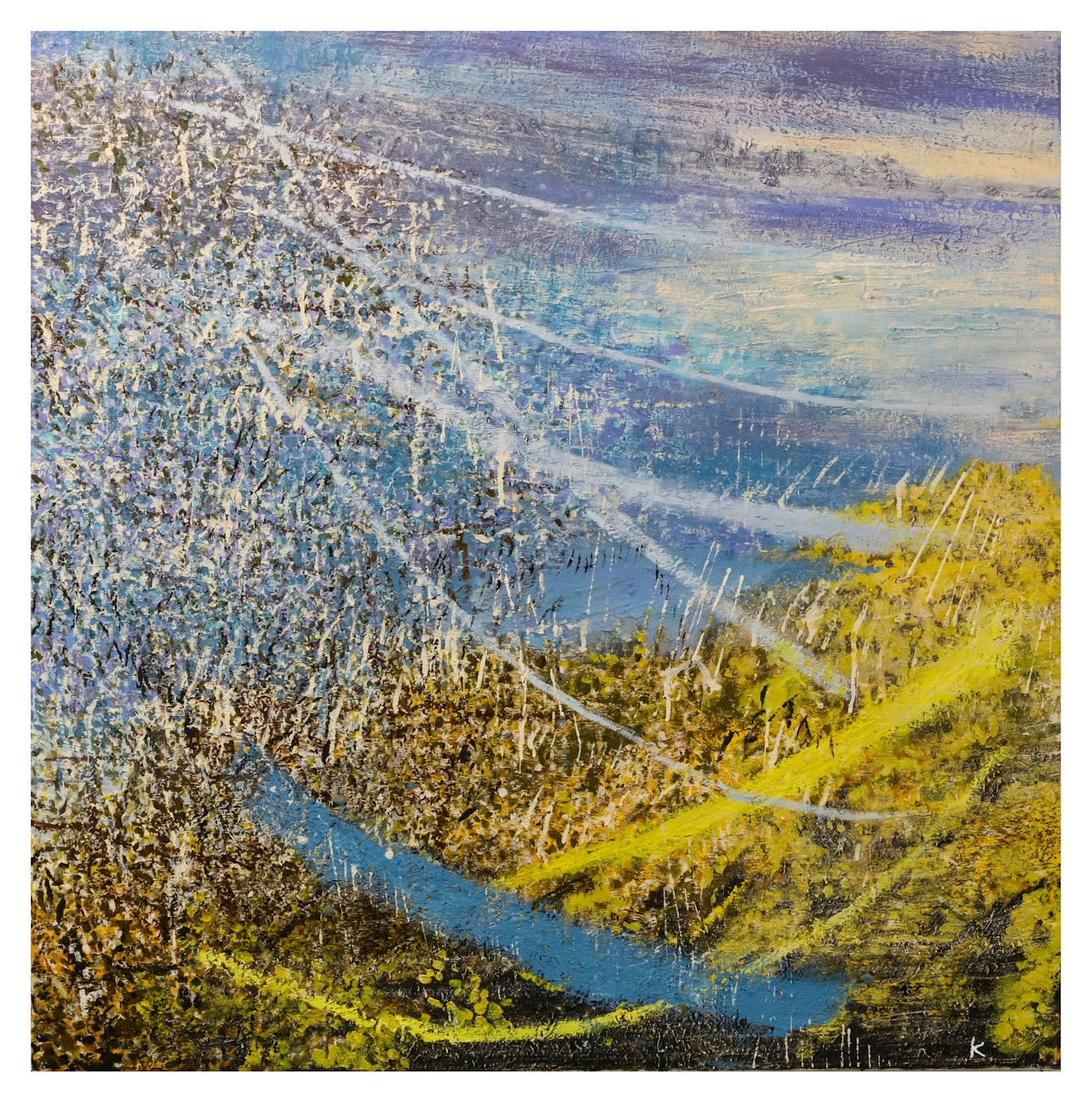
Excerpt from the Kylesku Project. Painting 4: Late afternoon. Oil on canvas. 120cm x 120cm. Audio: KBS Audio Artwork. © Keith Salmon.
Listen
Painstaking eyegaze creations
Sarah Ezekiel shares Keith’s love of the natural world. She tells me that “nature always inspires me with beautiful natural colours and shapes”. Her work has a fresh, clean air – there’s never any excess line or colour. The detail and positioning are modernist, with Sarah citing inspirations including Picasso, Hockney, Kandinsky and Modigliani.
The eyegaze system Tobii Dynavox lets Sarah control her mouse by using her eyes, and therefore paint in programmes like ArtRage or Revelation Natural Art. I’ve tried out this software and found the process painstaking. It required me to look at a point on the screen to select a mouse, look at the brush to select that, and then activate a different mode to click and drag the brush across the screen. It clearly requires a lot of talent, effort and experience to use.
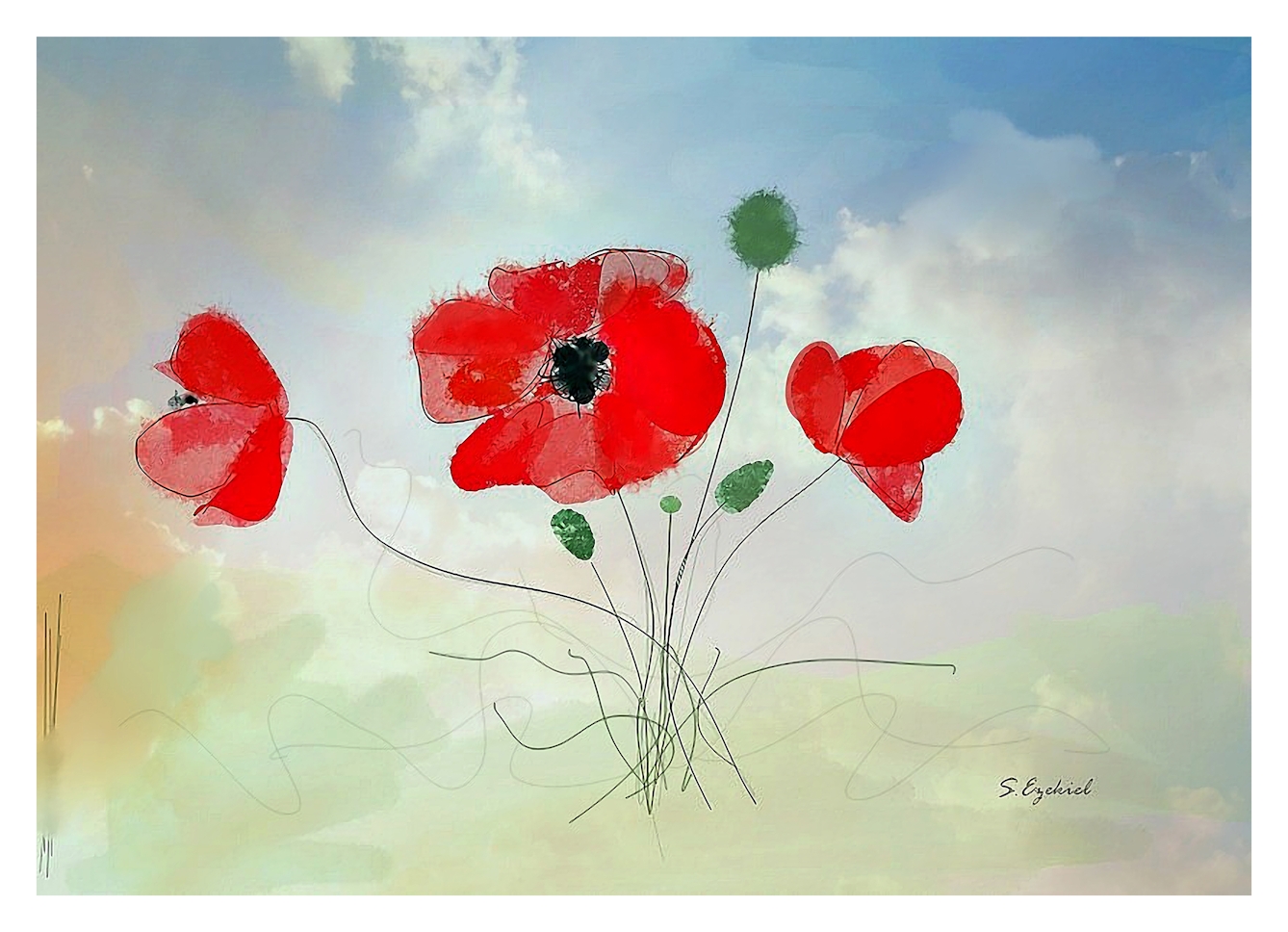
‘Seize the Day’, 2013. © Sarah Ezekiel.
Sarah currently uses a Grid Pad with a Tobii Dynavox eye tracker camera, but the eye tracker crashes constantly and she desperately needs to replace it with a better system. Eyegaze computers are expensive but essential for communication as well as making art. Sarah says she has been refused the £9,500 Tobii I-16 eyegaze system she needs and was offered an inappropriate one instead from the NHS. Tobii Dynavox estimates that its devices are provided to only about ten per cent of the people who need them.
In an interview for Creative Skills for Life, Sarah admits that creating art using eyegaze tools is a challenge, and that using her hands was much freer and quicker. Her paintings take several hours a day to complete over weeks or months, and the process leaves her eyes sore.

‘Peaceful Warrior’, 2014. © Sarah Ezekiel.
Keith has also found that his pace of work has slowed. While Sarah feels that MND has ultimately given her space to be an artist, Keith says, “If I hadn’t lost my sight in 1990 I’d like to think I’d be a long way ahead of where I am now.”
It’s encouraging to talk to artists who have continued to produce incredible work even as their impairments have forced them to alter their creative process. Keith, too, finds it inspiring to meet “other creative people who are dealing with different issues and are still going out and being successful”. While disabled people aren’t inherently inspirational, it’s a reminder of how adaptable we really are – and how talent and hard work will always show.
About the contributors
Jamie Hale
Jamie is an artist, curator, and founder and artistic director of disability arts organisation CRIPtic Arts. They create poetry, comedy, scriptwriting and drama for page, stage and screen, and are currently directing a showcase at the Barbican Centre for autumn 2021 and a disability arts documentary. They have written for Wellcome Collection and the Guardian newspaper and have performed at venues including the Southbank Centre. Their poetry pamphlet, ‘Shield’, was published in January 2021.
Kirsten Irving
Kirsten Irving is a Lincs-born, London-based voice artist and poet. She has voiced work for a range of organisations including the Fairtrade Foundation, Royal Botanical Gardens Kew and the Women’s Institute, and can be heard on the Mosaic Science podcast.
